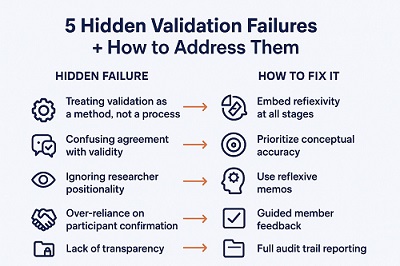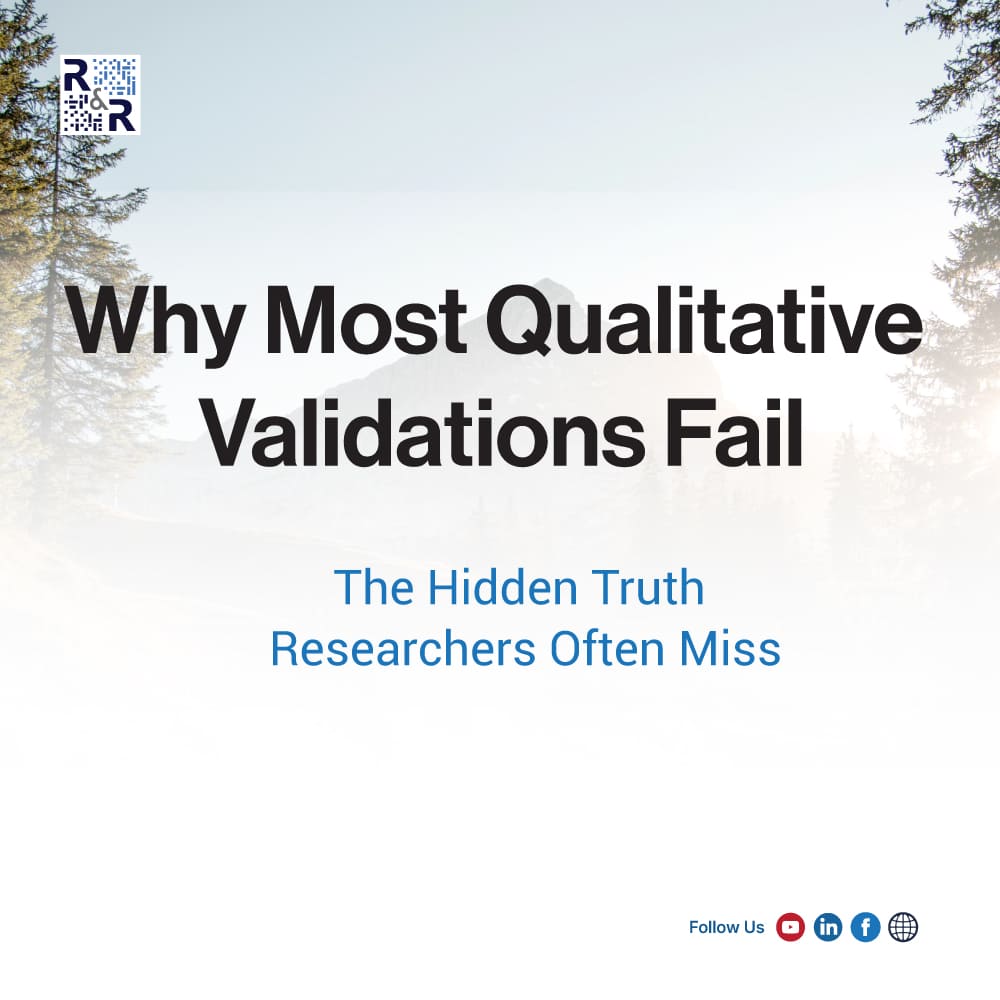Qualitative research is rich. But richness alone doesn’t guarantee validity. In fact, many qualitative studies fail validation due to subtle, often overlooked flaws. At Research & Report Consulting, we’ve audited hundreds of studies and identified recurring critical issues that most researchers don’t realize. Fixing these can elevate your findings from “interesting” to trustworthy.
Key Issues Undermining Qualitative Validation
1. Validation as a Method, Not a Process
- Researchers often apply one technique (e.g. triangulation) and assume their study is “validated.”
- True validation is iterative—from coding, theme development, through interpretation—at each stage evaluating credibility.
- Some frameworks (e.g. “iterative‐interactive process”) promote ongoing checking rather than one‐off validation steps.
2. Mistaking Agreement for Validity
- High intercoder agreement (or high coder reliability) does not guarantee conceptual correctness.
- If all coders agree on a flawed or superficial coding frame, bias just gets reinforced.
- What matters more is whether codes and themes map meaningfully to participants’ lived experiences, not just coder consensus.
3. Ignoring Researcher Positionality & Reflexivity
- Reflexivity written in methods sections often becomes a ritual, not a genuine part of analysis.
- Researchers’ assumptions, cultural background, relationship to participants influence interpretation heavily.
- Without explicit reflection and adjustment, these biases creep in invisibly
4. Over-Reliance on Participant Confirmation (Member Checking)
- Member checking is widely used but misused. Participants may agree out of politeness or because they misunderstand interpretations.
- Their confirmation doesn’t necessarily validate interpretative frames or theoretical abstractions.
- Use member checking selectively, using guided feedback and probing rather than open agreement.
5. Lack of Methodological Transparency
- Studies often skip details: how sampling decisions were made, how codes developed, how themes evolved.
- Without an audit trail (field notes, codebooks, documentation of coding changes), external reviewers or readers cannot assess credibility.
- Reporting checklists show many studies omit crucial sections like research team credentials, data saturation, verbatim quotes.
Real Evidences
| Study | Key Finding Related to Validation Failures |
| A Systematic Review (children & young people) | Many studies lacked reporting on sampling, data analysis, or research team details essential for assessing content validity. |
| Qualitative Nursing Research: Translational Perspective | Emphasizes validation as an adaptable, interdisciplinary tool rather than rigid adherence to conventional methods. |
| Validation tool “VAKS” | Shows utility in appraisal of qualitative studies; still shows disagreement on some items—indicating that even validated tools need context sensitivity. |

How to Do Better: Best Practices
- Embed validation throughout: from design, sampling, data collection, coding, to reporting. Not only at the end.
- Use multiple validation techniques, but with purpose: combining triangulation, expert review, peer coding, member checking, etc.
- Maintain audit trails: codebooks, memos, changes in codes/themes, translation steps (if any).
- Be transparent about researcher positionality: document your assumptions, biases, any changes in perspective during the study.
- Report with full detail: sample sizes, saturation, direct quotes, context descriptions, limitations.
References
- Schou L, Høstrup H, Lyngsø EE, Larsen S, Poulsen I. Validation of a new assessment tool for qualitative research articles. J Adv Nurs. 2012 Sep;68(9):2086-94. doi: 10.1111/j.1365-2648.2011.05898.x. Epub 2011 Dec 13. PMID: 22168459.
- Cruz Neto J, de Oliveira Lima A, Chaves Costa E. Qualitative nursing research: evidence of scientific validation from a translational perspective. Invest Educ Enferm. 2024 Mar;42(1):e11. doi: 10.17533/udea.iee.v42n1e11. PMID: 39083823; PMCID: PMC11290901.
- Husbands, S., Mitchell, P.M. & Coast, J. A Systematic Review of the Use and Quality of Qualitative Methods in Concept Elicitation for Measures with Children and Young People. Patient 13, 257–288 (2020). https://doi.org/10.1007/s40271-020-00414-x
At Research & Report Consulting, we help researchers and organizations strengthen the validity of their qualitative work — from design to reporting — ensuring findings are not just “rich,” but trustworthy and defensible.
📩 Want your qualitative study to stand up to expert scrutiny?
👉 Visit us at Research & Report or message us directly here on LinkedIn.

